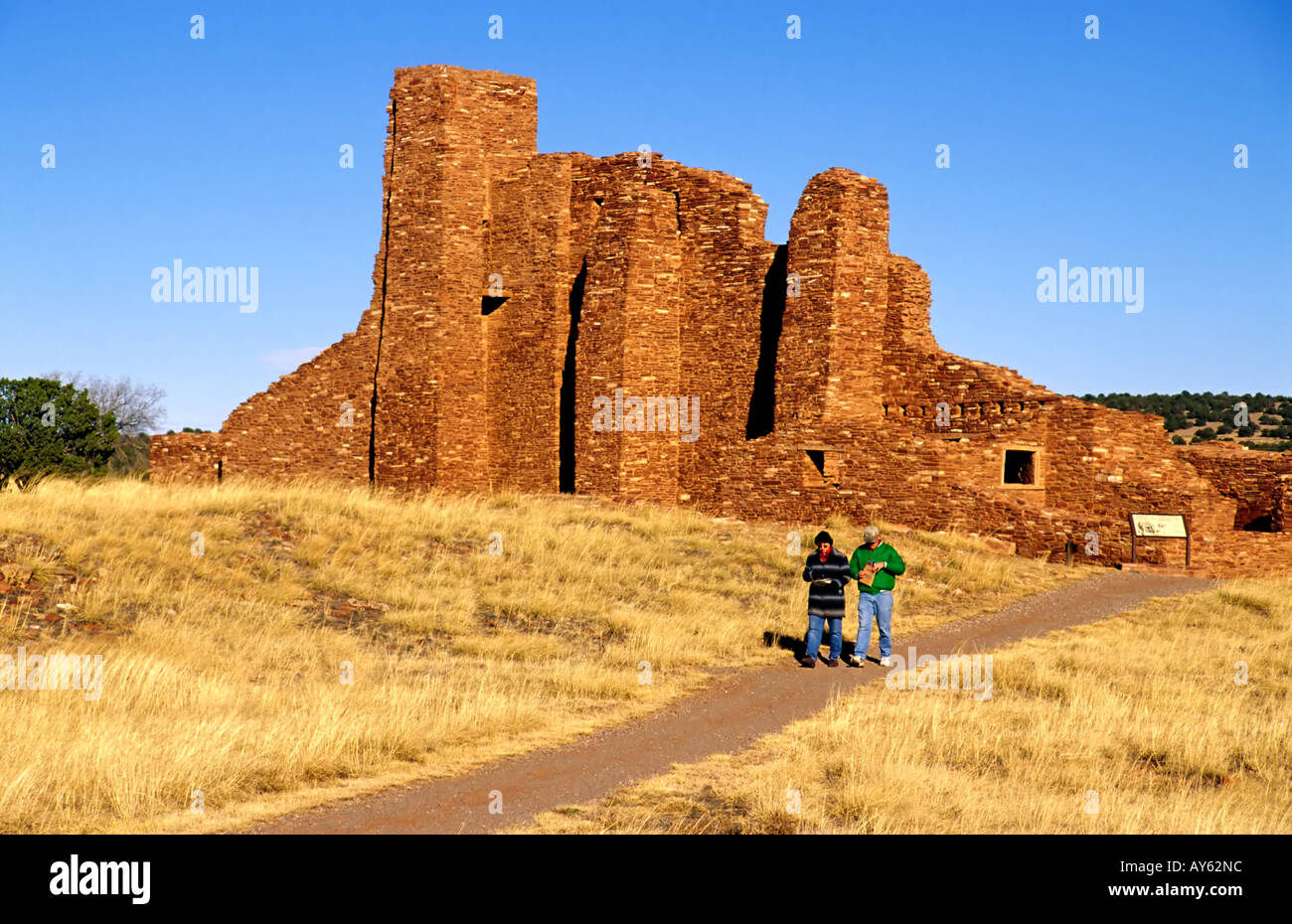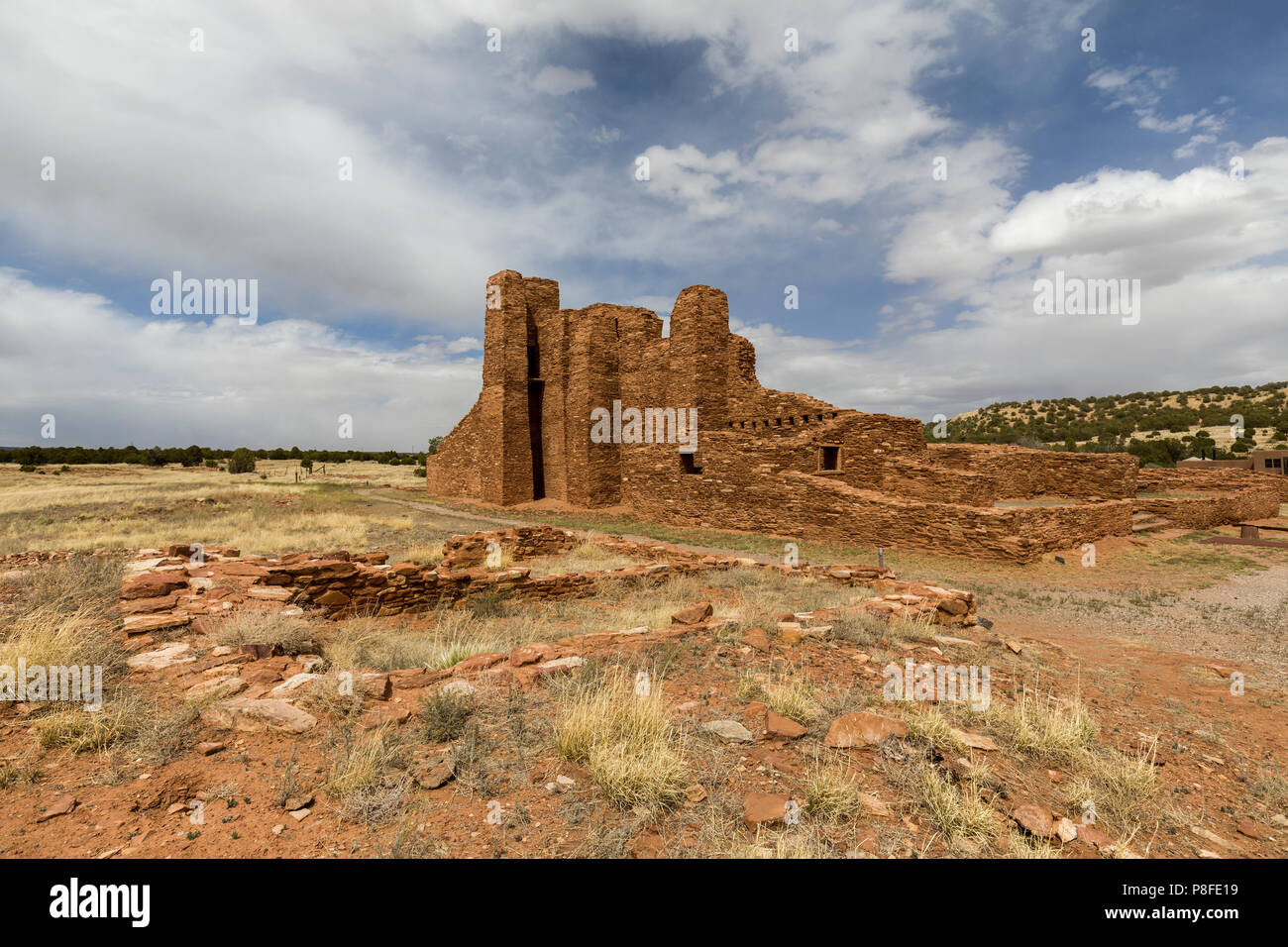
Echoes in the Stone: Unearthing the Complex Legacy of Abo, New Mexico
The high desert of central New Mexico holds its secrets close, etched into the wind-sculpted mesas and whispered through the rustling sagebrush. Here, beneath an impossibly vast sky that stretches from the Sangre de Cristo Mountains to the horizon, lie the skeletal remains of Abo, a site that tells a profound and often unsettling story of cultural collision, faith, and survival. More than just a collection of ancient stones, Abo is a powerful testament to the ambition of Spanish missionaries, the resilience of the Pueblo people, and the unforgiving nature of a frontier that ultimately swallowed both.
Today, Abo stands as one of the three principal units of the Salinas Pueblo Missions National Monument, a silent sentinel guarding centuries of history. Visitors approach it with a sense of reverence, the massive, honey-colored sandstone walls of the Mission San Gregorio de Abo rising abruptly from the arid landscape, an architectural marvel built by human hands against formidable odds. But to truly understand Abo, one must peel back the layers of time, venturing beyond the grandeur of its ruins to the lives that once pulsed within its walls and the complex forces that shaped its rise and fall.
A Pre-Columbian Crossroads: The Tompiro’s Domain

Long before the cross-carrying friars arrived, the area around Abo was home to the Tompiro-speaking Pueblo people, a vibrant and self-sufficient community. Their ancestors had tilled this land for centuries, cultivating corn, beans, and squash in ingenious dry-farming techniques. The Tompiro were skilled artisans, crafting intricate pottery and trading extensively with neighboring Pueblo groups and nomadic tribes like the Apache. Their strategic location, nestled between the Rio Grande valley and the vast eastern plains, made them a vital hub in a sophisticated regional trade network.
Perhaps their most prized commodity was salt, harvested from the nearby salt lakes – the "Salinas" that gave the future mission monument its name. This salt was not just a seasoning; it was a crucial preservative, a trading currency, and a sacred element in many indigenous rituals. The Tompiro pueblos, including Abo (originally called "Abó" by its inhabitants), were thriving, independent communities, deeply connected to their land and their ancestral traditions. Their kivas, subterranean ceremonial chambers, were the spiritual heart of their villages, where ancient rites were performed and community life was centered.
The Dawn of a New Era: Spanish Arrival and Missionary Zeal
The tranquility of the Tompiro world began to fracture in the late 16th and early 17th centuries with the arrival of the Spanish. Driven by a potent blend of "God, Gold, and Glory," conquistadors and Franciscan friars pushed north from Mexico, seeking new souls to convert and new lands to claim for the Spanish crown. In 1598, Juan de Oñate formally established the colony of New Mexico, and soon after, the Franciscans began their ambitious project of converting the Pueblo people to Catholicism.
For the friars, the conversion was not merely spiritual; it was a total transformation of life. They envisioned a "New Spain" where indigenous peoples would abandon their traditional ways, embrace Spanish language and customs, and labor for the glory of God and king. The Pueblo missions were central to this vision – not just churches, but self-contained agricultural and industrial centers designed to reshape native society.
It was in the 1620s that Fray Francisco Font arrived at Abo, a pivotal figure in its history. He was a man of immense faith and an equally immense ambition. Faced with an existing Pueblo village, Font set about establishing Mission San Gregorio de Abo. The task was monumental, requiring not only the spiritual persuasion of the Tompiro but also their physical labor to construct a church and convento (friary) on a scale previously unknown in the region.
The Grand Design: San Gregorio de Abo Takes Shape
The construction of San Gregorio de Abo was a feat of engineering and human will. Using local sandstone, quarried and meticulously shaped, the Tompiro people, under the guidance and often compulsion of Fray Font, began to erect a structure of astonishing proportions. The main church, with its towering walls, measured approximately 135 feet long and 35 feet wide, its massive buttresses supporting a heavy timber roof. Adjacent to it, a convento provided living quarters for the friars, workshops, kitchens, and classrooms.

"Imagine the sheer effort," remarked a park ranger during a recent visit, "hundreds of hands, hauling stone, mixing mortar, lifting massive timbers, all with rudimentary tools. It speaks volumes about both the friars’ determination and the Pueblo people’s skill, even if much of it was coerced labor."
The church’s design reflected traditional Spanish colonial architecture, yet it was infused with the unique character of New Mexico. The thick adobe and stone walls provided insulation against the desert’s extreme temperatures. Inside, a blend of Christian and indigenous symbolism likely emerged, as the Tompiro, while outwardly adopting the new faith, often continued to practice their ancestral beliefs in secret, integrating elements of Catholicism into their existing cosmology. This syncretism was a common response across the Pueblo world, a strategy of cultural survival.
Life at the mission was a complex tapestry of coexistence and conflict. The friars introduced new crops, tools, and livestock, aiming to improve agricultural yields and economic self-sufficiency. They taught Spanish, European crafts, and Catholic doctrine. For the Tompiro, this meant a radical restructuring of their daily lives, often involving forced labor, the suppression of traditional religious practices, and the imposition of a hierarchical social order. While some aspects of Spanish culture may have been welcomed, the overall impact was one of profound disruption and often, hardship.
The Crucible of the Frontier: Decline and Abandonment
By the mid-17th century, the mission at Abo, along with the other Salinas pueblos, reached its zenith. But the very forces that had allowed it to flourish on the frontier – its relative isolation and the hardiness of its people – would ultimately contribute to its demise. The challenges were multifaceted and relentless.
First, the unforgiving environment itself turned against them. A prolonged and severe drought gripped the region for decades, leading to widespread crop failures and famine. "The land simply stopped giving," one historian wrote, describing the devastating impact on both the Pueblo and Spanish populations.
Second, European diseases, for which the indigenous people had no immunity, swept through the communities with terrifying regularity. Smallpox, measles, and other contagions decimated populations, weakening the social fabric and further eroding the Tompiro’s ability to resist Spanish demands or fend for themselves.
Third, and perhaps most critically, the Apache, who had long traded with the Tompiro, became increasingly hostile. Facing their own pressures from drought and the Spanish presence, Apache raids intensified, targeting the mission’s livestock and food stores, and leading to the capture of Pueblo people for slavery. The Spanish, stretched thin across their vast colonial empire, were often unable or unwilling to provide adequate protection for the distant Salinas missions.
Caught between famine, disease, and relentless Apache attacks, the Tompiro population at Abo dwindled drastically. Their traditional way of life was shattered, their spiritual leaders persecuted, and their very existence threatened. By the 1670s, the situation became untenable. One by one, the Salinas pueblos were abandoned. Abo was among the last to fall silent, likely by 1672 or 1673. The surviving Tompiro, too few and too weak to maintain their community, were forced to migrate, many seeking refuge with other Pueblo groups along the Rio Grande. The magnificent church, a symbol of Spanish power and Pueblo labor, was left to the elements, its bells silenced, its altars deserted.
Rediscovery and Preservation: Abo’s Enduring Legacy
For nearly two centuries, Abo lay forgotten, its grand walls slowly crumbling under the desert sun and winter snows. It became a haunt for coyotes and a shelter for passing shepherds. Its story, however, was not entirely lost. In the late 19th and early 20th centuries, archaeologists and historians began to take an interest in the "lost missions" of New Mexico.
Early archaeological investigations by pioneers like H.P. Mera in the 1930s and extensive excavations by Joseph H. Toulouse Jr. in the 1950s began to reveal the complexity of Abo’s past. Their work unearthed evidence of the pre-contact Pueblo village beneath and around the mission, the details of its construction, and the devastating impact of its abandonment.
In 1938, Abo was declared a State Monument, and in 1980, it joined Gran Quivira and Quarai to form the Salinas Pueblo Missions National Monument, administered by the National Park Service (NPS). The NPS has since undertaken crucial preservation work, stabilizing the fragile ruins and ensuring that future generations can witness and learn from this extraordinary site.
Visiting Abo Today: A Journey Through Time
A visit to Abo is a profoundly moving experience. The site is remote, reinforcing the sense of isolation that once defined its existence. As one walks the interpretive trails, the silence is often broken only by the wind or the call of a hawk circling overhead. The massive sandstone walls, though roofless, still evoke the awe-inspiring scale of the original structure. One can trace the outlines of the nave, the sacristy, and the convento, imagining the daily lives of friars and Pueblo people alike.
"It’s like stepping into a time machine," reflected a visitor, gazing up at the soaring walls. "You can almost hear the chanting, the sounds of work, the whisper of ancient prayers. It forces you to confront the harsh realities of history, not just romanticized versions."
The kiva, partially reconstructed, stands as a powerful reminder of the enduring spiritual traditions of the Pueblo people, traditions that predated the mission and, in many forms, survived its demise. It symbolizes the resilience of a culture that, despite immense pressure, found ways to persist.
Abo stands as more than just a ruin; it is a profound educational tool. It challenges visitors to contemplate the complexities of cultural exchange, the consequences of imperial ambition, and the devastating impact of colonization. It forces us to confront uncomfortable truths about forced conversion, disease, and conflict, but also to recognize the ingenuity, adaptability, and unwavering spirit of the indigenous peoples who called this land home.
In the quiet solitude of Abo, the echoes of the past are palpable. The whispers carried on the desert wind tell a story of faith and struggle, of grand dreams and tragic ends. It is a story that reminds us of the fragility of human endeavors and the enduring power of history to shape our understanding of who we are and where we come from. Abo is not just a place to visit; it is a place to reflect, to learn, and to remember.


